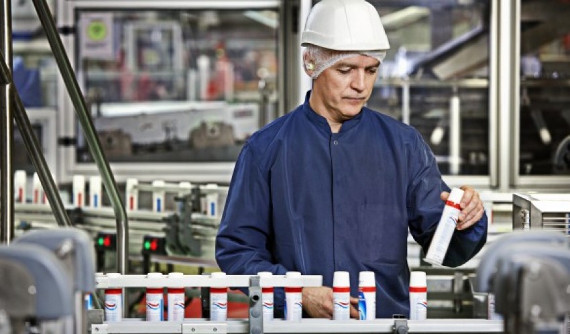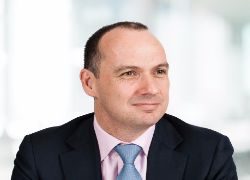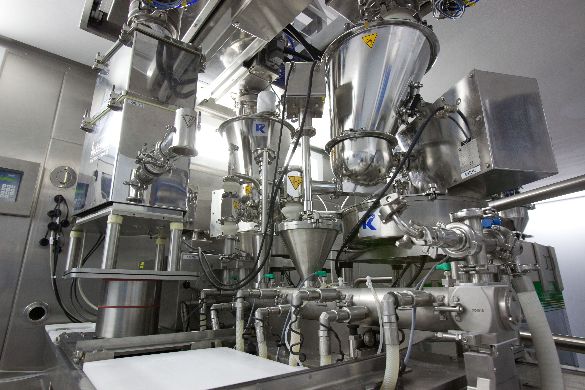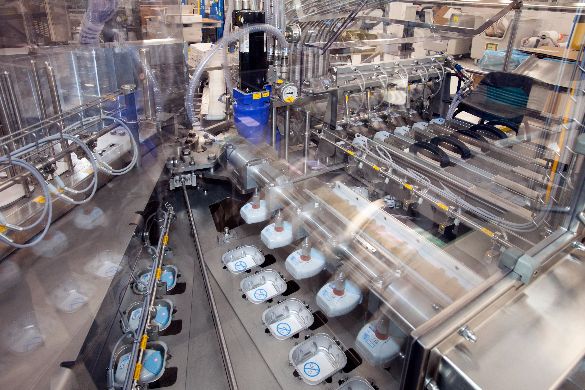Manufacturing leaders

Roger Connor is President, Global Manufacturing & Supply at GSK. He met Judith Shawcross, Head of Professional and Executive Development at the IfM, to talk about the time he spent in Cambridge on the Manufacturing Leaders’ Programme (MLP) – and how it remains relevant to the challenges he faces today.

Judith: How did you find yourself on MLP?
Roger: I’m an engineer by background and after university I trained as an accountant with PWC. But I always knew that I wanted to work in pharmaceuticals and, ultimately, in manufacturing and leadership. My first job after PWC was in finance with AstraZeneca. When an opportunity to join Glaxo Wellcome came up, working in respiratory products, I jumped at it. I was still in finance but I loved being on a manufacturing site. I joined my first leadership team looking after a value stream, overseeing the supply and development of product and the continuous improvement associated with that. When Glaxo Wellcome merged with SmithKline Beecham I moved to a central role, working on the network design that would bring the two manufacturing operations together. After that I moved to Cork, to be the finance director of our facility there. At that stage I was still hoping to move into manufacturing strategy but I didn’t know when or how. Then my boss told me that GSK used the MLP to give some emerging talents a different experience and to accelerate their careers and he suggested that it might be right for me.
It was exactly the right intervention at exactly the right time. It gave me both the content and confidence that I could make the transition from financial to organisational and strategic leadership. The minute I met the other people in the cohort I knew it was going to be great. The breadth of knowledge and experience in the room was very impressive.
What do you think are the most important things you took away from MLP?
When I look back at the course and think about what really made a difference, it was that blend of very practical knowledge of manufacturing combined with thinking about your own leadership style and approach. It was also very practical and relevant. Every project we worked on I was able to take back and apply in the factory.
Perhaps the most important thing it taught me was that everyone has the same issues as you and therefore someone will probably have already come up with the answers. You didn’t always have to re-invent the wheel. I often ask today’s emerging talent what ‘learn before’ they have done. By this I mean have they researched the problem, seen how other people have tried to solve it or have they dived straight in with a big-company mind-set, thinking that it has to be ‘invented here’?
The other big takeaway was that you have got to ‘go see’.

Oral care production at GSK Maidenhead, UK
Where did you ‘go see’ on MLP?
China. In 2005 we visited some incredibly large facilities, some that were very small, some that were fully state-owned and some which were partially state-owned. Seeing first-hand the rate of growth, the scale of it and some of the challenges of operating in China was eye-opening. I was blown away both by the calibre of the people we met – incredibly articulate, highly professional people with US MBAs – and by the scale of the operations. It seemed to me that if you were in China for low cost you were in China for the wrong reasons. You had to be there for the commercial opportunity.
We also visited a lot of UK factories. We learned to make an assessment of a facility quite quickly, using the things we were learning in the modules but also the experience of the other students. Automotive people, for example, looked at things like safety performance while pharma people were concerned with the quality system. Combining these different perspectives meant the companies we visited received really useful input from us and we benefited enormously from seeing the differences in how we all worked.
“It gave me both the content and confidence that I could make the transition from financial to organisational and strategic leadership.”
I introduced a production system at GSK based on much of the content that we talked about in Cambridge. One of our core tools is what the Japanese call Gemba – ‘go see’ – and my first experience of applying that approach was on those factory visits.
Then there was the leadership stuff. This introduced me to the idea of ‘leadership muscles’, the elements in your leadership style that you should apply each day: how to motivate, analyse and develop people and how to create energy.
“I was challenged to think about how you can you use manufacturing competence to differentiate yourself from the competition through strategic offerings such as quality, agility and cost competitiveness.”
The calibre of people brought in to talk on the programme was exceptional. Some of the subject matter experts were truly leaders in their field. For example, we learnt about the theory of constraints from Alex Knight from the Goldratt Foundation. It was Alex who said to me: “If you are using your calculator then you are not thinking strategically, you are working at too great a level of detail. You have to get it right ‘up here’, then sense check it and only then work on the details.”
Another big learning I had was the strategic importance of manufacturing. Until that point I thought about manufacturing as the process of creating an output. But I was challenged to think about how you can you use manufacturing competence to differentiate yourself from the competition through strategic offerings such as quality, agility and cost competitiveness. These are all elements of manufacturing strategy where you have to make balanced decisions. A big part of the programme was thinking about these trade-offs and I still apply that learning today when setting our strategic goals.

GSK's continuous tableting capabilities – a close collaboration between manufacturing and R&D
How much does the manufacturing strategy connect across broader functional areas within GSK?
You have to be more connected now, particularly in the new product introduction space. You can’t have any waste in your system. You need to take your commercial opportunity through to new product launch as quickly and efficiently as you can. Within the pharmaceutical sector there are certain challenges you have to overcome and manage – getting a product that is absolutely safe, that has been proven through clinical trials, that meets regulators’ expectations – all these are critical. But I also run our consumer manufacturing which has a faster innovation cycle. You need aligned commercial and supply teams and you also need geographic co-location to ensure that the idea sparked at the coffee machine can become a proposal and then reality in as short a time as possible. We have worked very hard to get exactly that synergy, to have a production person, a procurement person, a commercial person, a regulatory person, all sitting together thinking about the same product rather than dipping in through different processes at different times.
In our facilities in Ireland, the UK and Singapore we have co-located R&D and manufacturing to work together. We run some models where a product is developed in R&D and the chemists and engineers who have worked on it move with it through industrialisation and scale. I believe this approach lowers the risks associated with technical transfer, scale up and launch. The organisational lines have to be drawn somewhere: you have to have something called R&D and you have to have something called manufacturing. How you operate at that boundary determines the competitiveness of your organisation.
Another area we worked on in MLP was technology roadmapping with Rob Phaal. In pharmaceuticals we still have some way to go to make medicines more affordable and more accessible across the world. We used a technology roadmap to set a vision of how we want to take pharmaceutical manufacturing to another level. The beauty of the technology roadmap is alignment. There is no point in this being a single team’s goal. It has to be the organisation’s vision. You need the people who run the facilities, the people who develop your products, the people who procure your materials, the technical people who maintain your product always thinking about the goal together. Some people think of a roadmap as just a communication tool but I see it as a strategic intervention. It surfaces alignment. It forces people to ask themselves what they are trying to achieve.
If you were doing the course now – a decade further on with all the changes we see in the manufacturing landscape – what differences do you think would need to be made?
On the strategic side I would focus as much on the implementation as on the strategic development. Great strategies are only great when they have been implemented. In the real world 10,000 other things in the day job distract from the implementation. So I would want to think about what is the right operating model to drive execution? How do you ensure that what you say is the strategy is actually what’s happening on the ground? How do you check and adjust? MLP covered some of this but I think that we – and by ‘we’ I mean manufacturing as a whole – need to be better at doing what we say we are going to do. The other thing is that not all strategy can be written three years in advance. That it’s ok for strategy to emerge is a big insight for many people. They feel that if they are not executing what’s on the milestone plan they are not doing their job.
Particularly in this changing environment, you’ve got to have a strategic direction but you’ve got to be able to flex.
In the real world, real things happen so how do you make sure that organisations are properly prioritised and resourced? I would love to discuss how teams prioritise and stay focused on the mission and their critical goals. The other big issue that wasn’t part of the course is the digital age and its impact on manufacturing.
That is the big topic coming at us from all directions.
What does it mean for technology in the future? What does it mean for customer insight? What does it mean for the factory now? And we have to learn this.
New industries and also new, different models of value creation and capture. Is there a future in which you will be connected to the end-consumer as well as the doctors? And where bespoke prescriptions can be ‘printed’ on site at the pharmacy?
New manufacturing techniques will change the way the whole healthcare sector operates. Anyone who wants to lead in this environment now needs a new set of skills. You have to get that inspiration from the next generation and from new industries that didn’t exist ten years ago. If you try to solve it yourself it will take you too long.
“You have to have something called R&D and you have to have something called manufacturing. How you operate at that boundary determines the competitiveness of your organisation.”
Those are some of the things I would want to see in MLP if I were doing it now. But at the time, the programme was exactly right for me. It had been so well thought through – the operational aspects of manufacturing, the strategic aspects and the leadership – and then going out to see it in practice. There were only 12 of us on the course so we did get to know each other really well. We still talk to each other and look to share best practice. I can’t help smiling when I think back because although we worked incredibly hard it was such great fun.

GSK's new generation of respiratory devices in production at Zebulon, NC, USA
The Manufacturing Leaders Programme ran between 1997-2007. It comprised four three-week modules run over a two-year perior, culminatiing in a dissertation and the award of a Masters in Manufacturing Leadership. It was aimed at talented mid-career engineers and technologists who had the potential to move into more strategic roles in industry. If you are interested in developing your manufacturing leaders today, contact Judith Shawcross, Head IfM Executive and Professional Development.
IfM Review Issue 5 Articles



'A social network of things' - New approaches to asset management


 The Cambridge Value Mapping Tool
The Cambridge Value Mapping Tool












